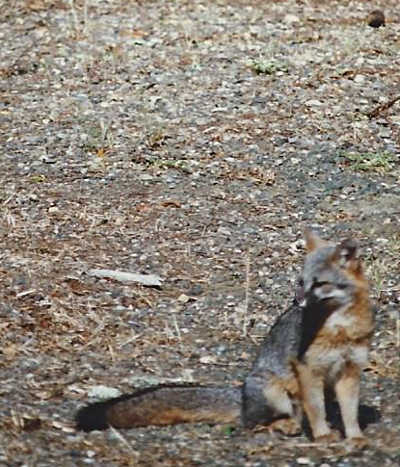
“There is a fox in me ... a silver-gray fox ... I sniff and guess ... I pick things out of the wind and air ... I nose in the dark night and take sleepers and eat them and hide the feathers ... I circle and loop and double-cross.” – Carl Sandburg
LAKE COUNTY, Calif. – The yipping, barking sound a fox makes can sound similar to a small dog.
I heard the barking for several days running, and thought a neighbor's small dog was loose.
One day the gray fox made herself known to me, and then I knew the “barking” was not a dog, but a fox, or vixen, as female foxes as called.
Now that I knew the sounds of a fox, I was not at all annoyed, but conversely, I listened ever so intently each time I left the house, for the sounds of the crafty fox, and it brought a smile to my face each time I recognized its call.
Throughout the course of the next few days, I was made privy to the antics of the vixen's kits. The young foxes are also called pups, or cubs.
The two rambunctious furballs played about, and tumbled - looking like blissful flashes of red and gray.
The pups ran about and took liberties with any gardening paraphernalia I had carelessly left about, such as gloves, plant marker-sticks and a hat.
The vixen stood guard and carefully watched over her young charges – the ever-dutiful mother.
Gray fox belongs to the biologic family canid, which includes coyotes, wolves and dogs.
Our neighbors since the Pliocene era of the geologic timeline, fox has been around for millions of years. Fossils found in Arizona are proof of this amazing fact.
The gray fox differs genetically from red fox, or Vulpes, and shares similar family lines with the ancient raccoon dog, Nyctereutes procyonoides as well as the African bat-eared fox, or Otocyon megalotis.
The male fox is known as a tod or a dog, while an assemblage of foxes is called, surprisingly enough, an earth, a leash or a skulk.
Gray foxes, or Urocyon cinereoargenteus, are omnivores, eating more small mammals in the east, but here in California they dine more often on insects, herbs and fruit.
Red foxes can be found in California, but, according to the California Department of Fish and Wildlife they are non-native and pose a threat to “vulnerable species and ecosystems because they are so highly adaptable and are such adept hunters.”
Fox features prominently in the mythology of many cultures. In Greek mythology the Alopekos Teumesios is known as an enormous fox that was disciplined by the gods to Thebes for committing a crime. Zeus flung fox up to the stars into the constellation Lepus (the Fox), or Canis Minor.
In Japan they call the fox kitsune, and they figure largely in the folklore of Japan. The fox is considered to be a character of high intelligence, with this attribute increasing with age. Kitsune feature magical characteristics in ancient Japan.
The folktales of Japan talk about the fox's affinity for tricking people, and that they can become shape-shifters, and remake themselves into women.
As a trickster, Japanese fox stories state that they can be merely mischievous or even malicious.
Some other characteristics fox possess in the Japanese culture are that they can have up to nine tails, and that the higher the number of tails, the more influence and power it exerts.
In contemporary culture the Japanese depict fox in many popular books and movies, such as anime, and they also show up frequently in video games.
“The earth has music for those who listen.” – George Santayana
Kathleen Scavone, M.A., is an educator, potter, writer and author of “Anderson Marsh State Historic Park: A Walking History, Prehistory, Flora, and Fauna Tour of a California State Park” and “Native Americans of Lake County.” She also writes for NASA and JPL as one of their “Solar System Ambassadors.” She was selected “Lake County Teacher of the Year, 1998-99” by the Lake County Office of Education, and chosen as one of 10 state finalists the same year by the California Department of Education.

 How to resolve AdBlock issue?
How to resolve AdBlock issue? 



